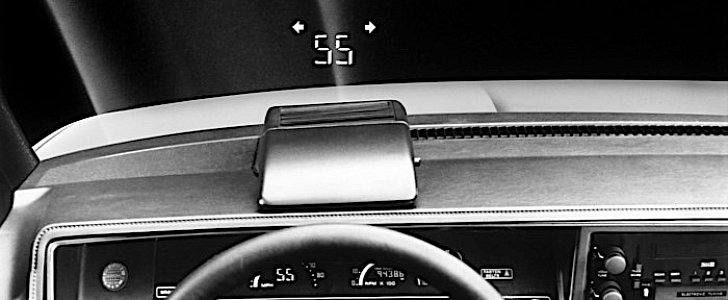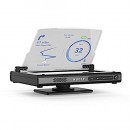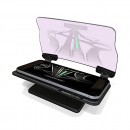The head-up display is a technology that helps relay information without the users having to lift their eyes from natural viewpoints. For years, this technology has been primarily used in military vehicles, but its use now expands to the automotive industry.
Historically, head-up displays (HUD) are said to be based on the reflector sight used on military aircraft even before World War II. The technology was drastically refined during the war, as the Allies needed a way to make their pilots more efficient, especially during night-time raids.
From there, HUDs slowly grew into a vital technology for the military. From the 1970s, the tech started being used in commercial aviation as well. In 1988, the Oldsmobile Cutlass Supreme entered the history books as the first production car to use a HUD.
Nowadays, HUDs are becoming increasingly commonplace on cars. There are a handful of carmakers that offer the technology as factory-equipment on their vehicles, and a lot more of companies that offer aftermarket solutions.
HUD Components
Typically, HUDs have three major components: a projector unit, a combiner, and a computer.
The projector produces an image of whatever needs to be displayed, the combiner redirects it so that it is shown in the user's field of view, and the computer ensures the connection between the HUD and the data that needs to be transmitted. In cars, this data usually pertains to the speedometer, tachometer, and navigation.
Efforts are now being made to come up with the next generation HUDs that use Augmented Reality to display far more information, including points of interest and even the recognition of humans.
How To Add a HUD To Your Car
The majority of the cars currently on the road do not have HUD displays. Luckily the number of aftermarket solutions available can quickly fix that problem.
Presently, carmakers use one of two types of HUDs for their cars: they either include them in the windshield itself, or use separate hardware in front of the windshield.
Most of the aftermarket solutions are add-ons separate from the windshield. That means installing one is as easy as it gets: just take it out of the box, find a suitable place on the dashboard to fit it on, link it to the car or smartphone, set it up and you're good to go.
Below you will find a short list of available HUD solution for cars. It's important to note that these systems do not generally depend on the type of car you own, meaning anyone can use them. Also, there's no legislation preventing their use.
Hudway Glass (ad) - The Hudway is a type of HUD that can be perceived as a mirror of sorts. It takes the images displayed on any smartphone (sized 6.2" x 3.1"), magnifies them by 20 percent and projects them onto a special screen.
The mount is to be fitted in front of the driver on the dashboard by using the included jelly glue. The images reflected by the screen are visible regardless of lighting conditions, says the manufacturer.
For people who like to go off-roading, the Hudway app that can run on the phone shows on the HUD pitching and rolling measurements.
The Hudway Glass sells on Amazon from $39.98.
Kivic HUD (ad) - The Kivic also works with a smartphone in tow, but in this case, there's no need to mount it inside the tool. The system connects wirelessly to the phone, showing everything that goes on Android and Apple devices on a 10-inch screen.
To install the Kivic on the car, all you have to do is push the sticker down on the surface where you need the device. It then needs to be plugged into the cigar lighter socket so that it has power.
This HUD does more than show info about speed and directions. It can also display messages and incoming calls, and can even link up with the rearview camera of the car to show images when reversing.
The Kivic sells from $220.00 on Amazon.
Pyle HUD (ad) - The Pyle solution uses no info from a smartphone, and it is the most retro-looking of the bunch.
The system is, in fact, a 5.5 -inch LED display that can be fitted on the dashboard to relay information directly onto a window filma bout speed, driving time, distance, and altitude.
The system needs to be plugged into the cigarette lighter to work, and the window film needs to be fitted on the windscreen so that it shows the required info.
Its manufacturer says it even has a GPS. And it needs to, as it will not be giving you directions from Google Maps or Waze.
The Pyle HUD sells for $44.99.
Hudly (ad) - This device needs a smartphone to work, as it casts whatever the phone shows directly on a built-in screen. Casting is done using a wireless connection.
To install the device, the first thing you have to do is plug it into the cigarette lighter. You then choose where to put it, connect it to the phone and you're all set.
The Hudly HUD sells on Amazon from $199.99.
Sherox HUD (ad) - Sherox is a HUD system that comprises the reflective film (although the manufacturer says it can be used without one), the HUD module, stickers to attach the module to the dashboard and an OBD line to link it to the car itself.
Once linked to the car and fitted on the dashboard, the Sherox shows info about speed, water temperate, battery voltage, and mileage right in front of the driver's eyes.
On Amazon, this device sells for $46.95.
From there, HUDs slowly grew into a vital technology for the military. From the 1970s, the tech started being used in commercial aviation as well. In 1988, the Oldsmobile Cutlass Supreme entered the history books as the first production car to use a HUD.
Nowadays, HUDs are becoming increasingly commonplace on cars. There are a handful of carmakers that offer the technology as factory-equipment on their vehicles, and a lot more of companies that offer aftermarket solutions.
HUD Components
Typically, HUDs have three major components: a projector unit, a combiner, and a computer.
The projector produces an image of whatever needs to be displayed, the combiner redirects it so that it is shown in the user's field of view, and the computer ensures the connection between the HUD and the data that needs to be transmitted. In cars, this data usually pertains to the speedometer, tachometer, and navigation.
Efforts are now being made to come up with the next generation HUDs that use Augmented Reality to display far more information, including points of interest and even the recognition of humans.
How To Add a HUD To Your Car
The majority of the cars currently on the road do not have HUD displays. Luckily the number of aftermarket solutions available can quickly fix that problem.
Presently, carmakers use one of two types of HUDs for their cars: they either include them in the windshield itself, or use separate hardware in front of the windshield.
Most of the aftermarket solutions are add-ons separate from the windshield. That means installing one is as easy as it gets: just take it out of the box, find a suitable place on the dashboard to fit it on, link it to the car or smartphone, set it up and you're good to go.
Below you will find a short list of available HUD solution for cars. It's important to note that these systems do not generally depend on the type of car you own, meaning anyone can use them. Also, there's no legislation preventing their use.
Hudway Glass (ad) - The Hudway is a type of HUD that can be perceived as a mirror of sorts. It takes the images displayed on any smartphone (sized 6.2" x 3.1"), magnifies them by 20 percent and projects them onto a special screen.
The mount is to be fitted in front of the driver on the dashboard by using the included jelly glue. The images reflected by the screen are visible regardless of lighting conditions, says the manufacturer.
For people who like to go off-roading, the Hudway app that can run on the phone shows on the HUD pitching and rolling measurements.
The Hudway Glass sells on Amazon from $39.98.
Kivic HUD (ad) - The Kivic also works with a smartphone in tow, but in this case, there's no need to mount it inside the tool. The system connects wirelessly to the phone, showing everything that goes on Android and Apple devices on a 10-inch screen.
To install the Kivic on the car, all you have to do is push the sticker down on the surface where you need the device. It then needs to be plugged into the cigar lighter socket so that it has power.
This HUD does more than show info about speed and directions. It can also display messages and incoming calls, and can even link up with the rearview camera of the car to show images when reversing.
The Kivic sells from $220.00 on Amazon.
Pyle HUD (ad) - The Pyle solution uses no info from a smartphone, and it is the most retro-looking of the bunch.
The system is, in fact, a 5.5 -inch LED display that can be fitted on the dashboard to relay information directly onto a window filma bout speed, driving time, distance, and altitude.
The system needs to be plugged into the cigarette lighter to work, and the window film needs to be fitted on the windscreen so that it shows the required info.
Its manufacturer says it even has a GPS. And it needs to, as it will not be giving you directions from Google Maps or Waze.
The Pyle HUD sells for $44.99.
Hudly (ad) - This device needs a smartphone to work, as it casts whatever the phone shows directly on a built-in screen. Casting is done using a wireless connection.
To install the device, the first thing you have to do is plug it into the cigarette lighter. You then choose where to put it, connect it to the phone and you're all set.
The Hudly HUD sells on Amazon from $199.99.
Sherox HUD (ad) - Sherox is a HUD system that comprises the reflective film (although the manufacturer says it can be used without one), the HUD module, stickers to attach the module to the dashboard and an OBD line to link it to the car itself.
Once linked to the car and fitted on the dashboard, the Sherox shows info about speed, water temperate, battery voltage, and mileage right in front of the driver's eyes.
On Amazon, this device sells for $46.95.






